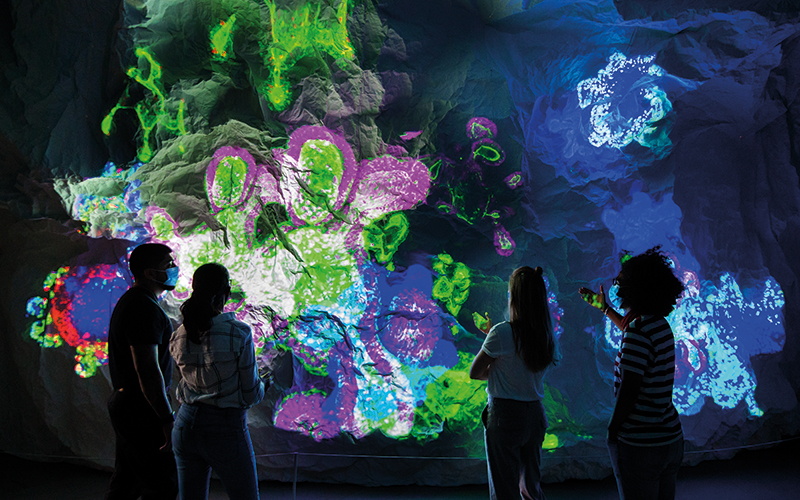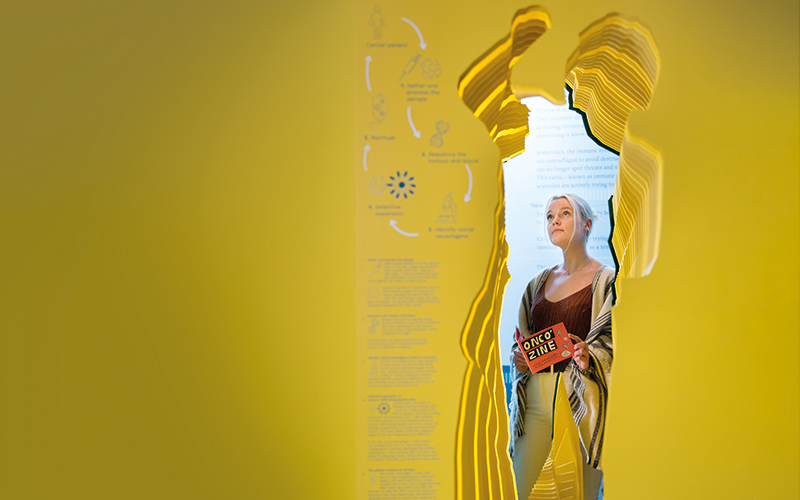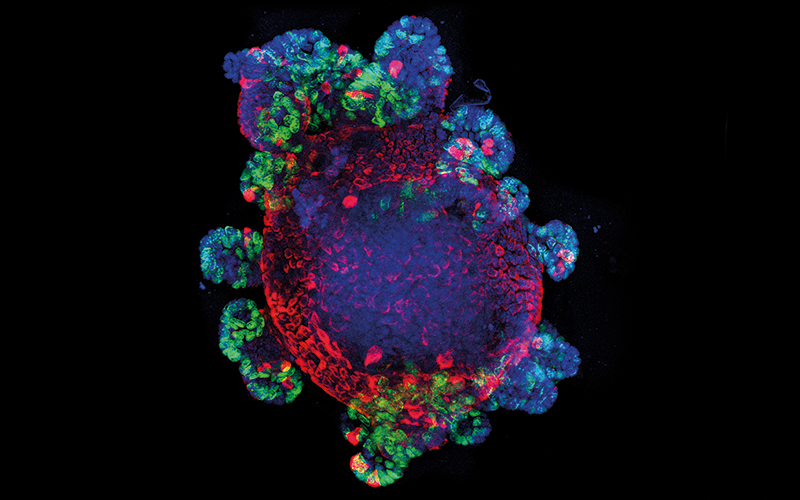The Francis Crick Institute has opened Outwitting Cancer – Making Sense of Nature’s Enigma, an immersive exhibition and the first to take place within a working science laboratory, home to cancer scientists from across the world. Here, Exhibitions Manager Hana Dethlefsen talks through the launch.

I understand this been in the pipeline for a while?
Yes – this exhibition was meant to open in 2020, but was delayed by about a year. In the meantime, the Manby Gallery was used as a vaccination centre, where more than 80,000 members of the public were vaccinated against COVID-19, including Prime Minister Boris Johnson, as well as the Leader of the Opposition, Sir Keir Starmer.
Why does the Crick put on exhibitions?
Public engagement is one of the Crick’s strategic objectives. Now, more than ever, it’s important for scientific institutions to be transparent about the process of science and to build trust with the public. It’s important to show how science is done, how we generate evidence, how assumptions and ideas change over time and how progress is ultimately made.
Our last exhibition welcomed more than 25,000 visitors in our Manby Gallery, and we hope we’ll reach as many with this exhibition, too.

What we do in the gallery isn’t restricted to art, but it’s certainly one of the tools we use to help make our science more accessible. Depending on the topic and how we choose to communicate it, the Crick has used multiple ways of interpreting and sharing the work that happens here in the building.
The Outwitting Cancer exhibition includes a large artistic installation – an immersive film and music experience developed by curator Yasmin Khan, filmmakers SDNA, and composer Mira Calix, using microscopy images from the Crick. We hope this immersive experience sets the emotional scene for the exhibition, priming visitors for the themes they will encounter later in the exhibition experience. Elsewhere in the exhibition, visitors will be able to watch filmed interviews, and experience images, objects, and text that explore the main themes of the exhibition.
How and why did you pick the people who are featured in the films?
Our curator, Yasmin Khan, did a wonderful job of selecting a variety of researchers to represent the work being done here at the Crick, alongside relatable non-experts with a stake in cancer research (see box). Whether they are people living with cancer, having a previous experience of it, or having a professional interest in cancer research, our “non-experts” are experts in approaching the topic from a layperson’s point of view – asking the types of questions our visitors would want to ask, but might be too shy or embarrassed to ask themselves. Yasmin wanted the exhibition to be relatable and uplifting, and so set up the pairings to explore the big questions – hopes, challenges and opportunities that are driving cutting-edge research into cancer.
Short films
A series of short films forms the backbone of the exhibition, and includes the following.
- BBC journalist George Alagiah, who is living with bowel cancer, meets Vivian Li, a stem cell and cancer scientist, as she creates “mini-organs”.
- Renowned cell biologist Mariann Bienz, who had a lung removed as part of her own cancer treatment, meets Charlie Swanton, Cancer Research UK’s Chief Clinician, to talk about the evolution of tumours.
- Lawyer and brain cancer patient Adam Blain, meets scientist Simon Boulton to talk about the role of DNA in cancer.
- Cancer Research UK’s Chief Scientist Karen Vousden talks to broadcaster and sex educator Alix Fox to bust some cancer myths.
- Crick scientist Erik Sahai meets Dr Georgette Oni, a trailblazing plastic reconstructive surgeon, as they discuss how cancer spreads.
- Dominique Bonnet, an expert in acute myeloid leukaemia at the Crick, gives journalist Tim Jonze, who is living with a rare blood disease, a behind-the-scenes tour of her labs.
Art and science have often historically been seen as opposing disciplines; is this starting to change?

Art and science are both ways of exploring the world, and although people may think of scientists as being rigid in their approach, I would think scientists know and can confirm that they need to be creative in their thinking to do the type of work they do. I know many researchers here at the Crick are talented in the arts, and that many explore their passions through various artistic means, including writing, music, dance and visual arts. There have always been explorations of scientific themes and topics through art, and I don’t see that changing.
“The impact of science on society is evident throughout history”
Why is it important that people understand more about life sciences?
The impact of science on society is evident throughout history – we could be in the middle of a biomedical revolution where our understanding and management of human disease completely changes. We need to engage and inform the public early when scientific advances or applications of science arise and to have healthy democratic societies with the right values and openness to debate.
What do you hope people will come away from the exhibition having learned or thinking about?
We hope people will walk away from Outwitting Cancer with a better understanding of what cancer is, and why it’s so hard to cure. The aim is to empower visitors to have positive discussions about cancer, to spark curiosity, and to provide the opportunity to dig deeper and find out more.
Exhibition info
Outwitting Cancer – Making Sense of Nature’s Enigma is a free exhibition running until 15 July 2022 at The Francis Crick Institute in London.
The gallery will be open Wednesdays 10am–8pm and Thursdays, Fridays and Saturdays 10am–4pm. Alongside the exhibition there will be a lively programme of events and talks, as well as an in-depth digital experience with additional exhibition content. Visit crick.ac.uk/outwittingcancer or @TheCrick for further details.
Image Credit | Vivian Li Lab Francis Crick Institute




